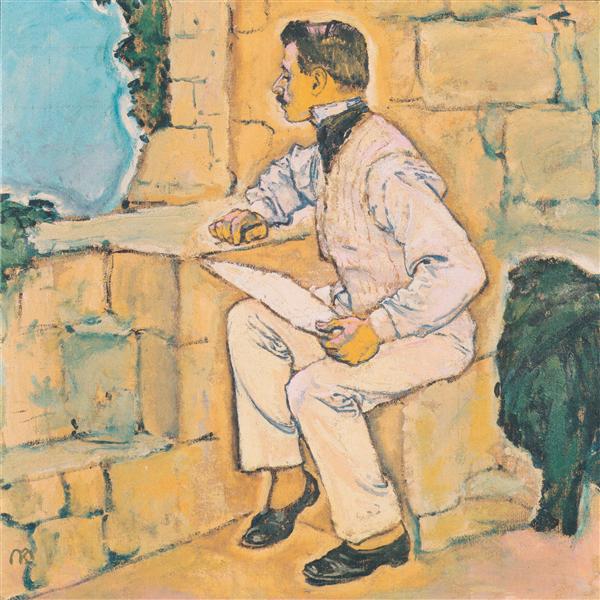Description
In the fascinating context of the Viennese art of the twentieth century, the work "Self -portrait" of Koloman Moser, painted in 1914, is erected as a revealing manifestation of the ethos of the movement of Vienna's secession. Moser, an outstanding and co -founder artist of this movement, has left an indelible mark on the history of art with his innovative approach that fuses art with crafts, giving a decorative and aesthetic character to painting and design.
"Self -portrait" is a work that captures not only the author's essence, but also his commitment to the symbolism and aesthetics of modernism. In the composition of the painting, Moser presents himself with an intense and reflective look, which invites the viewer to contemplate both the figure of the artist and the creative process that supports it. The frontality of his portrait, highlighting his figure in a daring colors and simplified shapes, establishes a direct connection between the observer and the observed, creating a dialogue that transcends the mere conventional portrait.
The chromatic deployment in "self -portrait" is undoubtedly one of the most shocking characteristics of the work. Moser uses a rich and vibrant palette, where the warm skin tones contrast with the bottom in blue and green that, without losing its decorative character, adds an emotional dimensionality to the piece. This color choice not only underlines the individuality of the portrayed, but also reflects the influences of symbolism, in how colors can evoke moods and sensations, acting as a reserve of personal and universal symbolism.
A remarkable aspect is the way Moser simplifies facial characteristics, suggesting instead of detailing. This stylization is representative of his style, influenced by Japanese art and the modernist aesthetics that moved away from naturalism. In the self -portrait, Moser Amalgama his personal identity with a visual experience that underlines the search for the balance between the human figure and its environment, creating a sense of harmony that is characteristic of many of his works.
Through this self -portrait, Moser not only presents himself, but also becomes an emblematic representation of the artist of the early twentieth century, at a time when the borders between art, decoration and everyday life began to blur. The search for authenticity and exploration of subjectivity are the background of their work, reflecting a historical moment where the concerns of modern art were intertwined with existentialist philosophy.
Koloman Moser's work can be analyzed with a sense of connection to other contemporary pieces that explore self -portrait from an unconventional perspective. Artists such as Egon Schiele or Gustav Klimt, who were also part of Vienna's secession, adopted similar positions when portraying the complexity of the human being, although each from their own stylistic vision.
"Self -portrait" is, therefore, more than a simple representation of the artist; It is an immersion in the psychology of the creator, a window at its interiority, to its emotions and thoughts, at a crucial moment, just before the outbreak of the First World War. The work is based as a testimony of the time of its creation and its relevance within the modernist movement, a genuine reflection of the restless and generating spirit of Moser. Thus, each line and every choice of color in this work becomes parts of a whole that invites reflection on the identity and place of art in life itself.
KUADROS ©, a famous paint on your wall.
Hand-made oil painting reproductions, with the quality of professional artists and the distinctive seal of KUADROS ©.
Art reproduction service with satisfaction guarantee. If you are not completely satisfied with the replica of your painting, we refund your money 100%.

